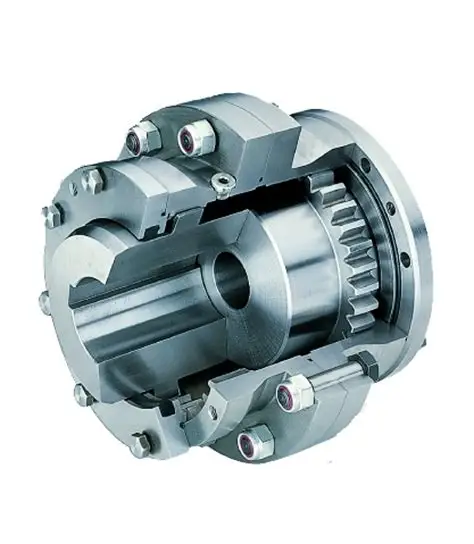GEAR COUPLING
Equipment couplings are torsionally rigid and are equipped to two types â completely adaptable and versatile/rigid. A fully versatile coupling comprises two hubs with an external equipment and two outer sleeves with an inner gear. It truly is a universal coupling for all kinds of applications and accommodates all possible misalignments (angular, offset and merged) as effectively as large axial moments. Equipment, bearings, seals, and shafts are therefore not subjected to the further forces, often of significant magnitude, which crop up from unavoidable misalignment generally associated with rigid shaft couplings.
A flexible/rigid coupling contains one flexible geared 50 percent and one rigid 50 percent. It does not accommodate parallel displacement of shafts but does accommodate angular misalignment. This sort of couplings are mostly utilised for “floating shaft” purposes.
Sizes 010 â 070 all have topped tooth with a 20° force speak to (fig one). This allows to accommodate up to one,5° static angular misalignment per gear mesh. Even so, reducing the operational misalignment will optimize the life of the coupling as nicely as the lifestyle of other machinery elements such as bearings and many others.
Equipment COUPLING
equipment coupling is a torsionally rigid grease loaded coupling consisting of two hubs with exterior multicrown – and two flanged sleeves with straight inner enamel. The flanged sleeves are bolted together with higher toughness corrosion safeguarded equipped bolts and nuts. The sleeve is at the opposite side of the flange executed with an endcap (inner for little and screwed for large size couplings) in which the o-ring is found for sealing purposes. The equipment coupling has been made to transmit the torque amongst these two flanges through friction staying away from fretting corrosion in between these faces.
The tooth of hub and sleeve are repeatedly in make contact with with each and every other and  have been designed with the essential backlash to accommodate angular-, parallel- and axial misalignment inside their misalignment capability. The angular and parallel misalignment capability is determined by the equipment tooth design and is for the normal equipment max. one.5° degrees (2 x .75°) in complete. The axial misalignment capacity is constrained by the equipment enamel size in the sleeve and can be varied (optionally).
have been designed with the essential backlash to accommodate angular-, parallel- and axial misalignment inside their misalignment capability. The angular and parallel misalignment capability is determined by the equipment tooth design and is for the normal equipment max. one.5° degrees (2 x .75°) in complete. The axial misalignment capacity is constrained by the equipment enamel size in the sleeve and can be varied (optionally).
Visit our site for more information concerning CHINA GEAR COUPLING.
